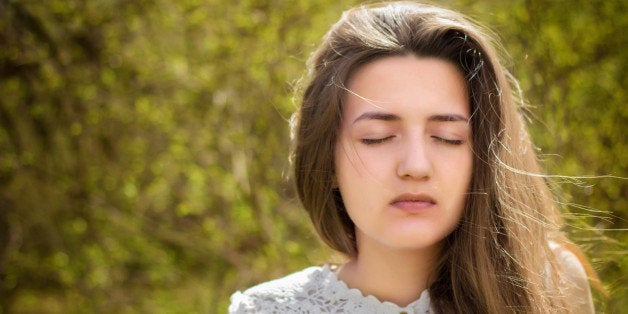
When we think of mindfulness, we may not think of teenagers.
But a growing body of evidence suggests that mindfulness practice could be beneficial to teens, helping them cultivate empathy, as well as skills for concentration and impulse control. In short, mindfulness can help adolescents navigate the challenges of adolescence.
As parents or teachers, we can introduce young people to the practice of mindfulness, or purposeful, nonjudgmental awareness. It might take some work, however, to convince teenagers of the value of slowing down, disconnecting from their digital devices and simply breathing.
So let's start with square one: getting "buy-in" when teaching mindfulness to teens.
1. Model Mindfulness
We can't show adolescents the benefits of a mindfulness practice without modeling it ourselves. This doesn't mean we always need to be paragons of contented bliss, but we should demonstrate our ability to manage stress and respond, not react, to setbacks.
Last year, as I handed out a revised course calendar to my high school students (due to having lost five days of school to the cold weather), one of my students said, "You seem so stressed out about this! Normally you're so chill!"
Her comment actually surprised me. I'm pretty intense and active when I teach (who wouldn't get fired up about European history?), but apparently, I still demonstrate a "chill" demeanor.
If we want students to take mindfulness seriously, they need to see it in action. They need to see us paying attention and handling challenges skillfully. Those millennial Holden Caulfields can spot a phony a mile away.
2. What's in it for Them?
Teenagers may see mindfulness as completely unrelated to their busy and connected lives. Here are a few research findings that you could share with them:
- Studies show that students who meditate before an exam perform better than students who do not
- Mindfulness practice can improve concentration
- Mindfulness-based interventions have been demonstrated to reduce the symptoms of anxiety, stress and depression (three things I see all too frequently in my students)
(For more information about the benefits of mindfulness and meditation, click here.)
3. Teach Teens About Their Brain
Adolescents are fascinated about how their brains work. We can teach teens how mindfulness instruction is like getting the owner's manual for their brain. This TEDx talk by Dan Siegel, author of Brainstorm: The Power and Purpose of the Teenage Brain, has a great demonstration that you can use with teens (or even younger kids) to teach them about the parts of the brain, using their hands as a model. (The demonstration starts at about the 12:00 mark).
The demonstration focuses on three structures of the brain: the brainstem (our "reptilian" brain, responsible for breathing, heart-rate, etc.), the limbic system/amygdala (our "mammalian" brain, involved in emotion and memory) and the cortex (our "human" brain, responsible for thinking and self-regulation). The hand model reveals how close the amygdala is to the pre-frontal cortex, and how mindfulness can help the thinking part of the brain process the raw emotion of the limbic system. And that can lead to better decision-making -- it allows a mindful pause, a skillful response instead of an unthinking reaction.
We can teach teens that mindfulness is a form of training for their brains: meditation has actually been shown to increase gray matter in the portion of the brain responsible for self-awareness and compassion. Mindfulness can play a role in the neuroplasticity of the brain -- our experiences can actually transform our brains, the way exercise can transform our bodies.
4. Teach Teens About Their Mind
When I teach mindfulness to my high school students, I use the analogy of the monkey mind, constantly jumping around from branch to branch, thought to thought.
When I did a mindfulness exercise with my students during a stressful week of finals, I explained that a lot of our anxiety is truly "in our heads" -- our stress comes from our worrying brains ruminating on all the worst possible scenarios. I gave this example: "You may think, 'I'm going to fail the final, my parents will be furious with me, I'll never get into a good college, and I'll never find a job!'" One student exclaimed, "Omigosh, have you been inside my head!?!"
When we practice mindfulness, we learn that much of the chatter of the mind is just that: chatter. It's not reality -- it's worry, it's anxiety, it's baseless projection. Mindfulness teaches teenagers to be aware of their thoughts, perhaps simply labeling them as "worrying." They can acknowledge anxiety, without getting caught up in the negative thoughts it generates.
Adolescents can discover that there are ways to approach the mind skillfully. This is often eye-opening!
5. There's an App for That!
I realize there's a bit of irony in recommending apps to practice mindfulness, especially to get teens to practice disconnection from their uber-connected cyberworlds. I use the Insight Meditation Timer when we practice mindful breathing in class, and students always want to know what app I am using. They love seeing the map graphic on the Insight Timer that shows all the locations worldwide where people are meditating.
Here are some of my favorite meditation apps for teens:
Stop, Breathe, and Think. My students like this app because it opens with a short "interview" where the user selects several words to describe how they are feeling, and then the app recommends guided meditations for their current state.
Smiling Mind. Designed for adolescents (and my students generally love anything with an Australian or British accent!)
Take a Break! Not necessarily just for teens, but it provides short guided meditations for stress relief.
I am wholeheartedly convinced that we can all benefit from incorporating mindfulness practice into our busy lives, especially teenagers. I hope these tips help you encourage the adolescents in your life to spend some time in digital detox, in stillness and in mindfulness.
This post originally appeared on Sarah's blog Left Brain Buddha. You can follow Sarah on Facebook, Pinterest, and Google+.